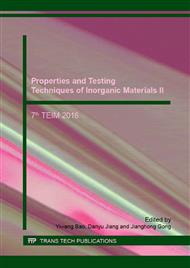[1]
P. M. K. Reddy, C. Subrahmanyam, Green approach for wastewater treatment-degradation and mineralization of aqueous organic pollutants by discharge plasma, Ind. Eng. Chem. Res. 51 (2012) 11097-11103.
DOI: 10.1021/ie301122p
Google Scholar
[2]
X. Q. Gao, F. Xiao, C. Yang, et al., Hydrothermal fabrication of W18O49 nanowire networks with superior performance for water treatment, J. Mater. Chem A. 1 (2013) 5831-5834.
DOI: 10.1039/c3ta10724h
Google Scholar
[3]
V. Iliev, D. Tomova, S. Rakovsky, et al., Enhancement of photocatalytic oxidation of oxalic acid by gold modified WO3/TiO2 photocatalysts under UV and visible light irradiation, J. Mol. Catal. A-Chem. 327 (2010) 51-57.
DOI: 10.1016/j.molcata.2010.05.012
Google Scholar
[4]
C. Peng, L. Q. Ming, L. Ye, et al., Superior optical properties of Fe3+-W18O49 nanoparticles prepared by solution combustion synthesis, New J. Chem. 39 (2015) 1196-1201.
Google Scholar
[5]
W. W. Zi, M. L. Xiao, J. W. Xiao, et al., Silver nanoparticles stabilized by bundled tungsten oxide nanowires with catalytic and antibacterial activities, J. Mater. Res. 29 (2014) 71-77.
DOI: 10.1557/jmr.2013.217
Google Scholar
[6]
U. Pikaned, H. Viyada, et al., A substoichiometric tungsten oxide catalyst provides a sustainable and efficient counter electrode for dye-sensitized solar cells, Electrochim. Acta 145 (2014) 27-33.
DOI: 10.1016/j.electacta.2014.08.096
Google Scholar
[7]
T. C. Xue, B. S. Shi, S. Y. Yan, Synthesis of tungsten oxide nanorods as visible-light-driven photocatalysts, Adv. Mate. Res. 148-149 (2011) 963-966.
DOI: 10.4028/www.scientific.net/amr.148-149.963
Google Scholar
[8]
K. Lee, W. S. Seo, J. T. Park, Synthesis and optical properties of colloidal tungsten oxide nanorods, J. Am. Chem. Soc. 125 (2003) 3408.
DOI: 10.1021/ja034011e
Google Scholar
[9]
F. Gallea, Z. C. Li, Z. J. Zhang. Growth control of tungsten oxide nanostructures on planar silicon substrates, Appl. Phys. Lett. 89 (2006) 193111.
Google Scholar
[10]
H. C. Lin, C. Y. Su, C. H. Chen. Direct growth of W18O49 nanorods on tungsten oxide films by rapid-annealing process, J. Sci. Innov. 2 (2012) 125-130.
Google Scholar
[11]
W. L. Jian, Z. Jing, L. W. Jin, H. Y. Shu, Ultrathin W18O49 nanowire assemblies for electrochromic devices, Nano. Lett. 13 (2013) 3589-3593.
Google Scholar
[12]
I. Kazeminezhad, R. Yousefi, Growth and characterization of ZnO/W18O49 heterostructures, Solid State Sci. 14 (2012) 349-353.
DOI: 10.1016/j.solidstatesciences.2011.12.001
Google Scholar
[13]
J. Thangala, S. Vaddiraju, R. Bogale, R. Thruman, et al., Large-scale, hot-filament-assisted synthesis of tungsten oxide and related transition metal oxide nanowires, Small 3 (2007) 890-1890.
DOI: 10.1002/smll.200600689
Google Scholar
[14]
S. G. Chong, Y. Shu, Y. Mei, et al., Morphology-controlled synthesis of W18O49 nanostructures and their near-infrared absorption properties, Inorg. Chem. 51 (2012) 4763-4771.
Google Scholar
[15]
K. Alireza, D. C. S. Reza, H. Younes, et al., Synthesis and characterization of dysprosium-doped ZnO nanoparticles for photocatalysis of a textile dye under visible light irradiation, Ind. Eng. Chem. Res. 53 (2014) 1924-(1932).
DOI: 10.1021/ie402743u
Google Scholar
[16]
S. Banerjee, S. C. Pillar, P. Falaras, et al., New Insights into the Mechanism of Visible Light Photocatalysis, J. Phys. Chem. Lett. 5 (2014) 2543-2554.
DOI: 10.1021/jz501030x
Google Scholar


